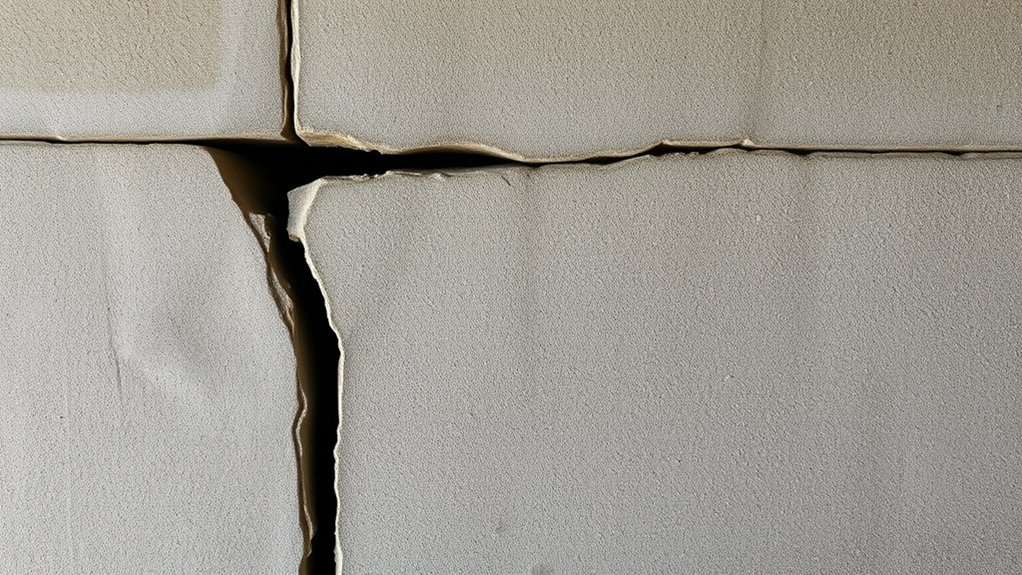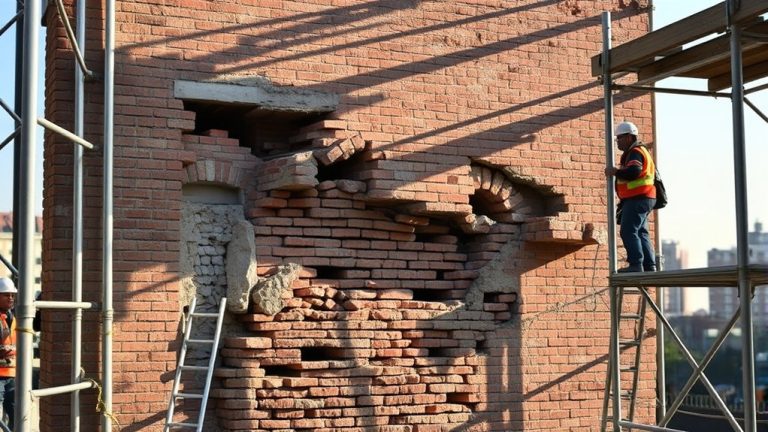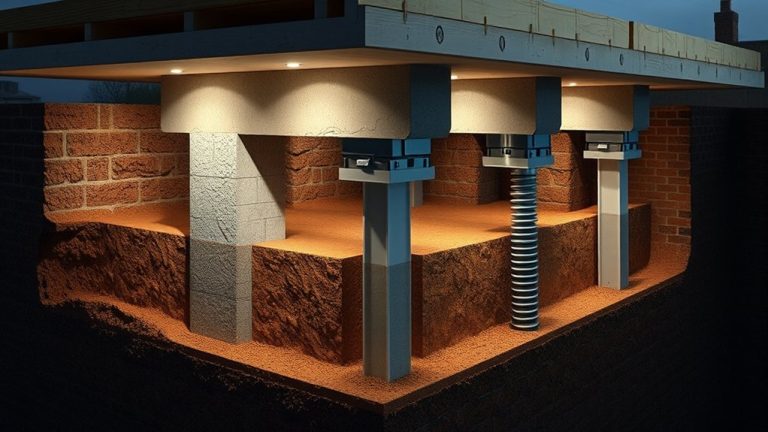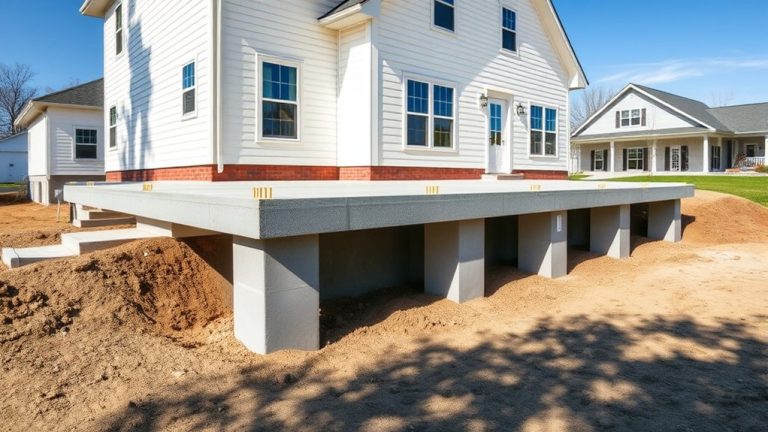Locating a bowing wall in your home can be nerve-wracking, but you’re not alone. These structural warning signs often indicate underlying issues that need immediate attention. From foundation problems to soil pressure, wall deformation isn’t just cosmetic—it’s a potential risk to your home’s integrity. You’ll want to understand what’s causing the damage and learn about professional solutions before the problem gets worse. Ready to reveal the secrets of wall repair and prevention?
Key Takeaways
- Bowing walls can be fixed using professional repair methods like carbon fiber strips, steel bracing, and wall anchors depending on the severity of structural damage.
- Early identification of warning signs such as horizontal cracks, bulging surfaces, and diagonal cracks near windows is critical for timely intervention and preventing further damage.
- Professional assessment using advanced diagnostic techniques like laser levels, digital measuring tools, and ground-penetrating radar helps determine the extent of wall damage and recommended repairs.
- Preventing future wall bowing requires implementing proper drainage systems, waterproofing measures, terrain grading, and managing soil conditions around the foundation.
- Contractor consultation is essential to evaluate the specific causes of wall bowing, such as foundation settling, soil erosion, and excessive moisture, and develop a targeted repair strategy.
Common Causes of Wall Bowing
Why do walls start to bow and bulge, causing homeowners significant worry? Typically, foundation settling and soil erosion are the primary culprits behind wall damage.
When the ground beneath your home shifts or erodes, it can create uneven pressure on your foundation walls. Poor drainage, excessive moisture, and unstable soil conditions can accelerate this process. Tree roots, inadequate backfill, and improper construction techniques also contribute to wall bowing. You’ll want to address these issues quickly to prevent further structural damage and potential costly repairs that could compromise your home’s integrity and safety.
Hydrostatic pressure from surrounding soil can exert tremendous force on foundation walls, leading to significant structural stress and potential bowing.
Early Warning Signs of Structural Damage
Before structural issues escalate, homeowners must recognize the critical early warning signs of wall damage. Carry out a thorough visual inspection technique regularly, looking for telltale signs like horizontal cracks, bulging surfaces, or uneven edges. These indicators can reveal potential structural integrity analysis needs. Foundation cracks like horizontal and stair step cracks can grow and present a serious danger to the building’s structural integrity.
You’ll want to check for diagonal cracks near windows and doors, which might signal foundation settlement or excessive soil pressure. Measure any visible wall deformation carefully, noting even subtle changes. If you notice persistent moisture, strange odors, or increasing wall movement, don’t hesitate—consult a professional structural engineer immediately to prevent costly repairs.
Professional Assessment and Diagnostic Techniques
When a bowing wall threatens your home’s stability, a professional assessment becomes your crucial first step toward resolution. Structural analysis techniques help experts diagnose the underlying causes of wall damage.
Professionals will use advanced diagnostic equipment, including laser levels, digital measuring tools, and ground-penetrating radar, to evaluate your wall’s condition. They’ll inspect foundation stress, soil conditions, and potential water damage. Their thorough evaluation will pinpoint whether you’re dealing with minor shifting or serious structural compromise.
Repair Methods for Bowing Walls
Since wall damage can escalate quickly, homeowners have several effective repair methods to stabilize and restore a bowing wall. Your first step should involve a contractor consultation to determine the severity of the wall’s condition.
Depending on the damage, professionals might recommend carbon fiber strips, steel bracing, or wall anchors for reinforcement installation. These methods can help prevent further structural compromise and restore your wall’s integrity. Each approach has unique benefits, so your contractor will assess which solution best fits your specific wall’s condition and your home’s structural requirements.
Prevention Strategies for Future Wall Stability
Preventing future wall damage requires proactive measures that homeowners can implement to protect their foundation’s structural integrity. You’ll want to focus on proper waterproofing measures to shield your walls from moisture intrusion and potential structural stress.
Appropriate drainage systems are indispensable in redirecting water away from your foundation, reducing hydrostatic pressure that can cause bowing. Install gutters with extensions, grade your terrain to slope away from the house, and consider French drains or additional waterproofing techniques. By taking these preventative steps, you’ll markedly minimize the risk of future wall damage and maintain your home’s structural health.
Frequently Asked Questions
How Much Does It Cost to Repair a Bowing Wall?
The average repair cost for a bowing wall ranges from $2,500 to $15,000, depending on severity. You’ll want professional installation options to guarantee a lasting, structural fix that’ll protect your home’s integrity.
Can I Fix a Bowing Wall Myself Without Professional Help?
You can try DIY wall bracing methods, but complex wall reinforcement techniques frequently call for professional proficiency. Serious structural issues need expert evaluation to avert potential collapse and safeguard your home’s security.
Will Homeowners Insurance Cover the Cost of Wall Repairs?
Your insurance policy might cover wall repairs, but it depends on the cause. Check your homeowner’s liability claims carefully, as sudden damage is more likely to be covered than gradual structural issues.
How Long Does a Typical Wall Repair Process Take?
You’ll typically spend 3-7 days on a wall repair, with the average timeline ranging from a weekend project to a week-long process, depending on the complexity and extent of the damage.
Are Bowing Walls a Sign of Serious Foundation Problems?
Bowing walls can signal critical structural integrity issues threatening your foundation’s stability. You’ll want immediate professional assessment to prevent potential collapse and safeguard your property’s structural health.



